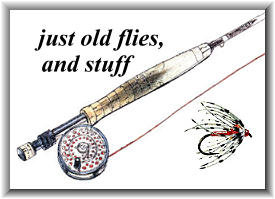I do not know any fly fisherman that would not like to
be able to take trout fairly consistently. I also do
not know of any trout fly fisherman that would not like
to extend his fishing time a little as the day draws to
a close. Likewise, I know few trout fly fishermen that
use wet flies, and herein lies the ambiguity. Trout are
primarily subsurface feeders, but I find this fact is
often forgotten in favor of the dry fly. I also know
many trout fly fishermen that use nymphs, but ignore the
staple wet fly.
Historically, the wet fly, in its varied forms, is the
basis for fly-fishing, as it is known. Fly fishermen of
days gone by relied heavily on the wet fly as their means
of taking fish. For a time, except for some dappling with
long rods and horsehair leaders, the sunken fly was most
productive, and I lament the fact that it goes unused
and somewhat unappreciated today.
Over the years, I've taught beginning fly fishers how to
participate in the sport via the wet fly. This is not
because wet fly fishing is easy. Far from it, as many
wet fly techniques require great skill.
Wet fly fishing, is, however, a logical first step in the
learning process. Fly fishing roots are centered in
wet-fly tradition. With a fairly simple wet fly technique,
beginning students offer the fish an imitation in a place
where trout are most at home, in the water.
I'm sure many will ask, "Why use wet flies, when nymphs
work well below the surface?" I suggest using nymphs for
specific fishing situations when it can be determined the
fish are taking nymphs. I know there are other situations
when trout feed underwater but do not feed on nymphs. The
most widely known of these times is during emergence, and
yes, there are specific patterns developed especially for
this, too. I find, however, that wet flies work just as
well, if not better.
I know certain species of mayflies and caddis actually hatch
underwater to swim to the surface. The naturals are best
imitated by winged and wingless wets. I also am aware of
the fact that certain species of mayflies and caddis swim
below the surface to deposit eggs. Winged and wingless wets
also do a great job imitating these, too. Why ignore them?
There is a plethora of wet flies from which to choose. Many
patterns come from the early days of fly-fishing in the
British Isles. Most of these flies are of the imitative
type. The early American wet flies are often derived from
their British counterparts, but others were especially tied
for fishing to the native brook trout. These flies are
very colorful and still are effective, today. For those
that would definitely like to try fishing wets, I suggest
narrowing the selection of patterns down a bit until the
techniques and selected fishing spots are learned. The
following patterns are the ones that I feel will start
any fisherman wanting to try wets, on the path to success.
At the top of my list is the Gold Ribbed Hare's Ear.
The Hare's Ear is probably one of the best-known wet
fly patterns ever tied. Definitely an immigrant from
the British Isles, I find it simple to tie and deadly
when fished in various sizes. By far, however, the
larger fish like it in sizes 10 and 12. In fact in
early spring I often fish the pattern in size 8 on a
sinking line. The fly shown here, is a variation of
the original. The original pattern was tied using only
the guard hair of the fur as legs. I have added a
partridge hackle, and to me, this makes the fly even
more successful.
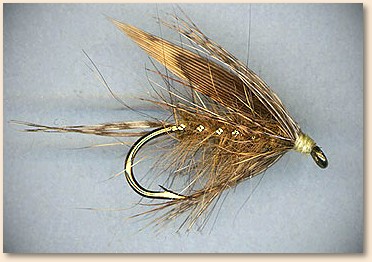
Hook: Standard wet fly sizes 8-14
Thread: Yellow
Hackle: Brown partridge or woodcock
Tail: Hen pheasant
Ribbing and Tag: Flat gold tinsel
Body: Natural Hare's Ear taken from the lobe of the
ear dubbed Leisenring style.
Wing: Grouse Primary
Note: The wings are tied on first, then the hackle
is wrapped last. After tying the wings on, I dub
and tie a little more fur in front of the wings,
then wrap the hackle.
My next choice is the Leadwing Coachman. I consider it
part attractor, part imitative, and while it can be
fished in various sizes, larger trout seem to like it
in sizes 10 and 12. Because of the peacock herl body,
this fly can be weighted easily to get it deep.
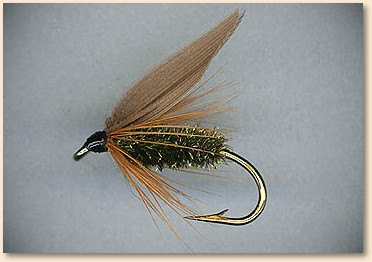
The Cowdung, my next choice, is another import from the
British Isles. I've found this fly in a number of
variations. Some are tied with floss bodies, but I
prefer a version tied with fur. This fly works great
in sizes 10-14.

Hook: Standard wet fly 12-16
Thread: Orange
Hackle: Red-brown hen
Tag: Flat gold tinsel
Body: A mix of olive, yellow, tan, and orange rabbit
fur. The overall appearance is olive-orange. This
is dubbed Leisenring style.
Wing: Cinnamon Turkey
Note: The wings are tied on last, after the hackle.
My next selection is the March Brown. This fly, which is
like its cousin the Hare's Ear, is a great fish catcher
that will attract larger fish when fished on sizes 10 and
12. Also like the Hare's Ear, a version tied on a size 8
hook often brings in big trout.
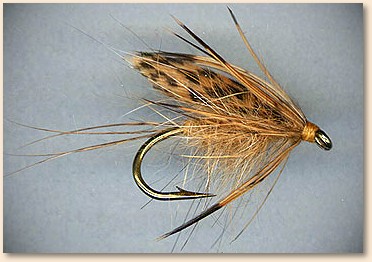
Hook: Standard wet fly sizes 8-12
Thread: Orange
Hackle: Brown partridge or grouse
Tail: Brown partridge fibers
Ribbing: Doubled tying thread
Body: Fawn colored Hare's Ear on orange thread dubbed Leisenring Style
Wing: Partridge Tail or cinnamon turkey
Note: The wings are tied on first, then the hackle is
wrapped last. After tying the wings on, I dub and tie a little
more fur in front of the wings, then wrap the hackle.
Anyone that knows me knows I am a firm believer in the
wingless wets developed in the British Isles and adapted
by Leisenring and Hidy to America's waters. I find these
flies are very versatile, and I have written articles on
these flies alone because of their fish catching abilities.
I'd be remiss if I did not include some of them in my
selection.
By far, one of my favorites is a Black Gnat as tied by
Leisenring. This fly has taken numerous fish for me and
for others I've fished with. I like this fly tied in size
14, but I had it work well in smaller or larger sizes.
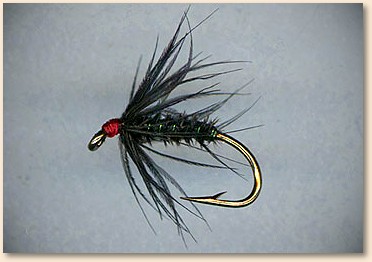
Hook: Standard wet fly sizes 12-18
Thread: Red
Hackle: Purplish starling
Rib: (optional) Fine green wire
Body: Three fibers taken from the V-shaped dark
brown-black section of a turkey tail
Note: Leisenring's original pattern did not have
the wire. I added it for strength.
The Orange Fish Hawk is a real favorite of mine. It
catches all types of trout. I found the pattern in
Trout and Ray Bergman has nothing but
praise for it. While I employ it wet, It can be tied
and fished dry as well. I suggest it in sizes 12 and
14. I tie it soft-hackle style.

Hook: Standard wet fly sizes 12-14
Thread: Black or dark brown
Hackle: Badger hen
Ribbing and Tag: Flat gold tinsel
Body: orange floss
Lastly, I must suggest a fly I put together, myself. It is
similar in nature to the old favorite Light Cahill, but
there are some differences. It's fashioned after a Hare's
Ear in style and it has worked well when cream-colored flies
are around. I suggest it in various sizes from 10 through 14.
I call it the Genesee Jewel because on my home river, there
are many hatches of light colored flies.

Hook: Standard wet fly sizes 10-14
Thread: Pale yellow
Hackle: Dark cream or pale ginger hen
Tail: same as hackle
Ribbing and Tag: Fine pearlescent tinsel
Body: Cream colored hare's ear dubbing done Leisenring style
Wing: Lemon wood duck
Note: The wings are tied on first, then the
hackle is wrapped last. After tying the wings on, I dub
and tie a little more fur in front of the wings, then
wrap the hackle.
Before I get into techniques, I feel I should note
wet flies can be fished in teams, two or three flies
at once. This, to me, makes them especially effective
because flies can be offered at three levels in the
water column. I fish my flies both as teams and as
single flies. When fishing flies in teams, it is not
uncommon to hook two trout at once. One of the techniques
I'll discuss actually requires that the flies be fished
as a team.
Team fishing can be accomplished by rigging leaders with
droppers. I suggest that anyone considering fishing teams
of wets learn to tie their own leaders. I often can teach
a student to tie leaders in no time. It's just a matter
of getting some leader formulas and learning how to tie
a blood knot. This is all that's needed. I create my
dropper tags simply by leaving the tag ends of the heavier
of the two pieces of leader material. These tags should
be no longer than four inches. For a team of three flies,
I tie one fly on the tip, one fly up near the knot that
connects the tippet to the body of the leader, and then
one more fly on the next knot up.
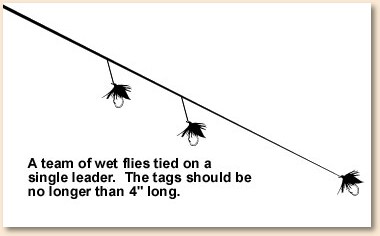
I find fishing wet flies can be very easy at times. In
fact I find it very relaxing. One of the easiest methods
I teach new students is called, appropriately, the
"downstream swing." I find many fly fishermen are
quite familiar with this term. It is really nothing
more than making a quartering cast up river to a spot
where the fly or flies will be introduced to the water.
I choose the spot to cast to by judging the speed of
the water and the depth I wish the flies to sink to
when they reach the point where they come alive. I
select the point by looking for fish or a spot where
a fish might be. Often, to insure that the tip or
single fly reaches the depth I want it to be, which
is usually below midwater, I may mend the line to give
the fly even more sink-time.
After I make the initial cast upstream. I allow the
flies to sink following their progression with the
rod tip, usually rotating my stance toward the fly.
I usually hold the rod parallel to the water. The
line will move down river. The flies/fly should
begin to "swing" in the current as it gets hold of
the line and the flies will rise to the surface,
naturally. If I judged the depth, speed and distance
correctly, the flies come alive at the point where the
fish is or should be.

Of course, this procedure could be done in a searching
manner without any specific target or fish in mind. It
will often trigger a response from fish sitting, waiting
for food. I prefer to cast to likely spots or to fish,
directly, but that does not mean I never use a searching
fly. I prefer to use the search method as the light fades
at the end of the fishing day. I can cover a stretch or
pool without having to see the fish, and can often fish
past dark.
I have also perfected a variation of the swing, which I
feel needs to be noted. Often times, as the fly/flies
begin to swing and come alive, I employ and "hand twist
retrieve." This method is also called the "hand over
line" retrieve. I also gently wiggle the rod tip. This
method is deadly more often than not, and also works
extremely well doing the searching swing in the evening.
The next method I like definitely requires a team of flies.
The number of flies in the team is determined by water depth.
For deeper stretches, the three-fly team is better. It works
extremely well in faster riffs and runs and in the faster
water of springtime.
I execute this technique much like the swing. The flies
are cast either across or slightly up and across on a
fairly short line. When the flies hit the water, the
flies are only allowed to sink partially. The top fly
actually remains at the surface. There, it should flutter
and constantly flick in and out of the water. The retrieve
is quick, pulling the flies in, with the top dropper working
its magical jig. The rod is held high to the flies, and the
line hand uses the hand-twist to help bring them in. Again,
I rock my hand, gently, to add action to the flies. This
method is deadly when caddis are fluttering near the surface.
I've never seen any method in dry fly fishing that can
duplicate the action of egg-laying insects. This method does.
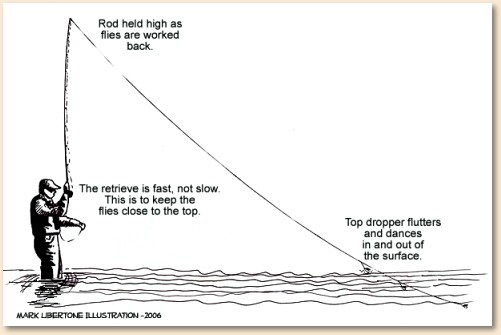
When fishing large waters, I suggest using fairly large
flies for any of the wet-fly techniques. I find smaller
streams can effectively be fished using smaller flies,
too. For leader lengths, I like short leaders of about 7
feet for the quick retrieve method with a team of flies.
I find the swing method works best on regular leaders
fitted for the depth and clarity of the water. For normal
conditions I use a 9 ½ footer.
These flies and the techniques to fish them are not new.
The few techniques I've mentioned, here, are just the
beginning. I try variations of these dependent upon
circumstances, and I've not even begun to discuss the
upstream wet fly, which is also effective. What I hope
I've done is persuade some of those fishermen that shun
the wet fly in favor of the dry to give these historical
and deadly flies a try.
Authors Note: I would be remiss if I did not say
that I learned about these flies and techniques from
years of reading about them and fishing the wets. Other
great anglers have successfully used these flies for years
before I was even born. I believe that anyone that wants
to learn more could reach back across the years via the
printed pages of books, some of which are out of print,
but still available. My teachers were many, and I list
some of them, here, and thank them all for sharing.
The Art Of Tying The Wet-Fly and Fishing The Flymph, by James Leisenring and Vern Hidy.
The Sports Illustrated Book Of Wet-Fly Fishing, actually written by Vern Hidy.
Trout, by Ray Bergman.
Taking Larger Trout, by Larry Koller.
Fishing The Dry Fly As A Living Insect, by Leonard Wright, Jr.
How To Take Trout On Wet Flies and Nymphs, by Ray Ovington.
The Soft-Hackled Fly Addict, by Sylvester Nemes.
Wet Flies, by Dave Hughes.
About Mark:
I began fly fishing and tying at the age of 14. I had no
one to teach me as my father was not a fisherman. My
maternal grandfather, however, was. While he was not
into fly-fishing, he did inspire me to seek the wary
trout. I then became infatuated with the idea of fishing
the fly after seeing Bing Crosby fly fish on the TV show
The American Sportsman. Since then, I have taken
my fly rod wherever I go. It came with me to Germany when
I was stationed, there. It has given me hours of pleasure
through my 58 years, and helped me meet and appreciate a
lot of fine people along the way.
I look at fly tying as an art. I do this because I am a
trained artist and art teacher. It is my belief that tying
can be and is a creative process, very much like sculpting,
yet with soft materials. Innovative tiers are constantly
amazing me with new ideas and creations. It is, like any
art, a never-ending process.
I am married, with five grown children and nine wonderful
grandchildren. I have only one son, who fly fishes, but
two of my four sons-in-law enjoy fly-fishing. I have a
grandson and granddaughter that want to learn. We fish
together, often, and while I have enough skill to get by
on the stream, I never stop learning more about this great
pastime. ~ ML
|
